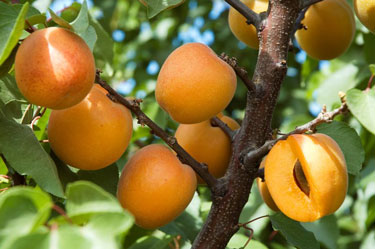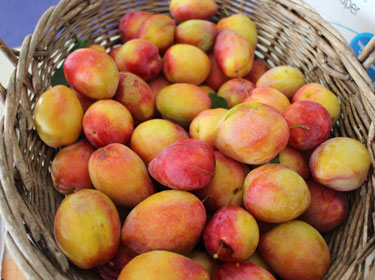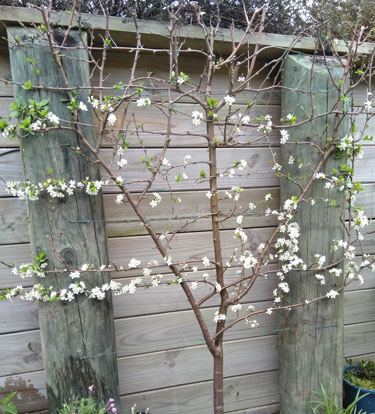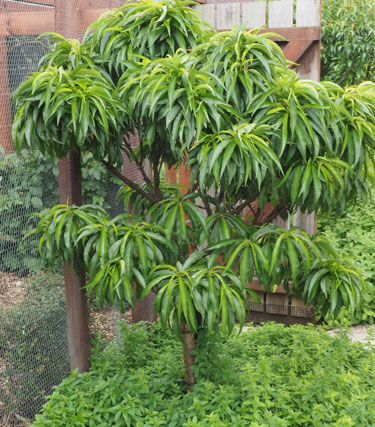Grow stone fruit
Cherries, apricots, peaches, nectarines and plums - those delectable treats we know as stone fruits - have more than their ‘stone' in common. All grow on pretty spring blossom trees that fruit in summer. That central stone is surrounded by sweet juicy flesh that’s devoured fresh from the tree or gathered up to make desserts and preserves.
Winter brings about a dormant phase for stone fruit trees, marking a key time to plant new trees for bountiful future harvests. With the many varieties available, maturing from early to late season, you can plan a spread of harvest dates. Many plums, and some cherries and apricots require another variety to be grown nearby to ensure pollination, so check with your garden centre to find which pollinators are required if any.
Also worth knowing when deciding which varieties to plant is that stone fruit trees have a ‘chilling requirement’. The need a certain number of hours below 7℃ to set fruit. Most cherries need 700-800 hours and apricots 500-600 while plums are happy with less. Our more temperate climates are the most suited to growing the widest array of stone fruits, but varieties with ‘low chill’ requirements grow well in the warmer, northern areas of New Zealand.
Planting
The key to success with fruiting trees is a thriving root system. Hence a little extra time and money spent preparing good soil at planting time will pay off.
Choose a sunny position, sheltered from strong winds. Stone fruit trees will grow in most soils, but in heavy clay soils, it helps to raise the planting area and add lots of compost. Clear the site of any weeds and debris. Make sure your trees are well watered before planting.
Dig a hole that is two to three times wider than the tree's root ball and of a similar depth. Loosen the soil in the bottom of the hole to encourage root penetration and water drainage, and sprinkle in a measure of a slow-release fertiliser. This will feed your new trees as they grow for a few months. If your soil is poor or compacted, amend it with a planting mix or quality compost to improve fertility and structure.
Your new trees will require staking to aid establishment and keep them straight. Install stakes before planting to avoid damaging the roots. For best results use 2 or 3 stakes about 20cm away from the trunk, and secure with soft fabric ties.
Gently remove the tree from its container. With newly potted trees, the potting soil is likely to fall away from the roots. Use this to mix with the soil from the hole and create a mound in the centre of the hole to fan the root system over. The tree should be positioned so that the soil level after planting is the same as the level in the pot.
Backfill the hole with the original soil, gently firming it by hand around the roots to eliminate air pockets. By watering well at this point, you also help the soil to settle, as well as giving the tree and surrounding soil a good drink.
Feeding
In spring, give your trees an annual dressing of lime or gypsum in August, followed by an application of Fruit Food in September. A layer of mulch laid on the surface in October will prevent moisture loss and greatly benefit the trees.
Pruning
Pruning is important to establish the shape of your young trees, and for continuous fruiting and maintaining shape of established trees.
If you have several fruit trees, and other plants that need pruning (such as shrubs and roses), then it is wise to invest in good quality tools and to keep them clean and sharp. You will need a pair of secateurs, a pair of loppers and a pruning saw to adequately prune all types of wood.
For many gardeners, pruning fruit trees is a scary challenge. What to cut out? What to leave? But when you know what shape you want and which wood they produce their fruit on, the challenge is easier.
Three basic shapes for fruit trees:
- Vase shape is the traditional open-centred framework with 3 to 5 main leaders. Start by cutting the central stem off about 80-100cm from the ground to encourage leaders to develop. When these have grown in the second year, cut them back to 30 or 40 cm from the main trunk, to encourage branching.
- Central leader or pyramid shaped fruit trees uses less space, and trees can be kept narrow. If your tree is a single rod, cut the stem at approx. 80cm high and encourage 3 or 4 side laterals. The strongest new growth will come from the first bud below where the pruning cut is made, so retain this to be the next central leader. Repeat the process at 1.4m and 2m high. This creates three layers of branches.
- Espaliering is an ideal method of training and pruning where space is limited. This involves creating a framework of branches over a flat vertical space. Because trees naturally grow upright it is necessary to start with the main leaders splayed out close to the ground. Thereafter prune to achieve an even, flat layer of fruiting wood.
Plums, cherries, and apricots fruit on spurs for several years. New spurs form as old ones die. Pruning mainly involves removing most new growth, plus old dead or diseased wood, to control size and maintain an open shape for light and air movement, and easy picking.
Peaches and nectarines fruit on one-year-old wood. That is, the wood that grew last year will carry fruit this year. Hence when pruning, shorten this one-year wood to half its length, and remove the other half of one-year old wood totally. This will encourage new growth from that point next year, enabling size to be maintained, and keep growth thin enough for light to penetrate and easy picking.
It’s preferable to prune stone fruit late summer and autumn after last harvest. However, if pruning in winter, always prune on a dry sunny day with preferably a few more dry days to come. This reduces the risk of diseases penetrating the pruning cuts. Seal any pruning cuts larger than 2cm with a pruning paste and spray with copper and spraying oil. This will protect the smaller cuts and reduce overwintering pests and diseases.

1-Jun-2024

Cherries

Peach 'Sweet Perfection'

Apricot 'Tomcot'

Plum 'Luisa'

Espaliered plum tree

Dwarf nectarine tree

